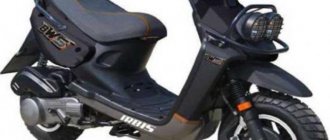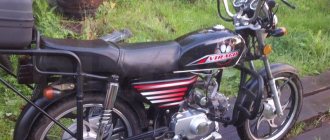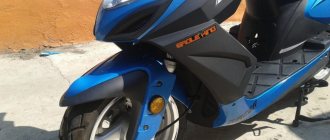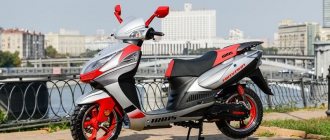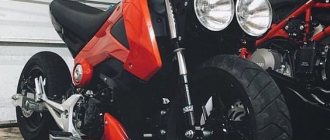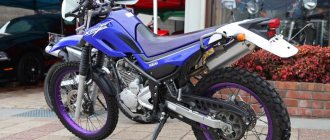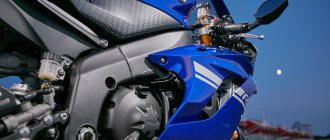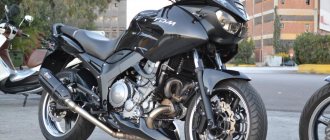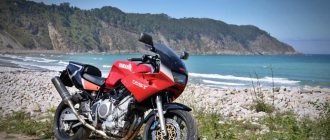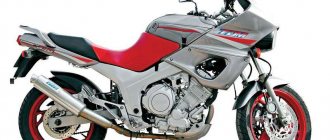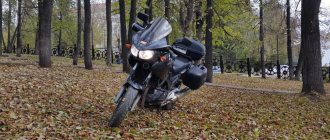Engine oil
SAE - viscosity-temperature classification of motor oils. Example - SAE 10W40, where: 10W is a winter viscosity grade, 40 is a summer viscosity grade. The lower the first number, the lower the viscosity and the easier it is to start the engine in winter. The higher the second number, the more the oil will retain its viscosity when heated. When the manual prescribes a viscosity grade, this is not an absolute requirement, but minimum conditions. For example, 5W40 is suitable when 10W40 is prescribed. The thicker the oil when cold, the longer the oil starvation will be when the engine starts. If you don’t have time to let the engine warm up well while driving, then you need to use oil that is thinner when cold: 5W, if you really need to fly or if the poor engine is stored outside at −10°C. For operation in difficult conditions, engines with high mileage (high play, gasoline ingress), for old monocylinders and air vents, oil with a hot viscosity of xxW50 . Under no circumstances xxW20 or xxW30! The use of more viscous types of oils will reduce the waste of the oil itself.
In addition to SAE, there is also an API - based on quality and the presence of additives. Old manuals for TTR indicate the outdated SE class (motor oils for gasoline engines produced in 1972-79). You can forget about the API, because... Each subsequent category is introduced to exceed the requirements of the previous one and completely replaces it. Nowadays there are practically no motor oils with a quality class lower than SF.
The Japanese came up with their own oil certification, the most complete - JASO. JASO MA standard oil is suitable for motorcycles with a wet clutch . Later, a restriction on phosphorus content was introduced, since catalysts appeared in so many motorcycles, and the JASO MA class was divided into two subclasses: MA1 and MA2. JASO MA2 also features a higher coefficient of friction than MA1, resulting in smooth clutch operation. The TTR can be filled with oil of both subclasses, but for the branded Yamaha “clear” gearbox, kmk, MA2 is more suitable =)
Pouring mineral water/semi-synthetic water/or synthetic water is a personal matter for everyone. The numbers in the manuals correspond to the mineral water from Yamalube. The only advantage of mineral oil is the price. Such oils have long been replaced by universal semi-synthetic type 10W40: any weather (from -20 to +35), any type of use for almost all types of current motorcycles at a minimal price. If you want to indulge, the recipe needs to be clarified. Only synthetics can be liquid when cold and maintain the required viscosity at operating temperatures. In the temperature range, synthetics rule. Its advantages are also an extended replacement interval and excellent cleaning properties. Because With intetics it washes out dirt better, old coked seals can leak. This must be taken into account when changing oil on heavily worn engines.
During normal operation, it always makes sense to use more expensive and high-quality oil. It oxidizes more slowly (longer lifespan), less sensitive to temperature changes, high speeds, etc.
you shouldn’t get carried away and fill the TTR with racing oils Additives to reduce engine wear will not work without high temperature and pressure, and the reduced content of antioxidant and detergent additives leads to the need for more frequent oil changes. Typical viscosity of racing oil at 100 degrees Celsius is w50, w60. This is great when, during normal operation, the engine is designed for w40 oil; in a race, the oil heats up more and the thicker oil is diluted to the design viscosity. However, if the racing oil is only warmed up to normal operating temperature, then part of the engine's power will be spent fighting viscosity, which in turn will help to increase the engine's operating temperature.
Petrol
What kind of gasoline should I use?
The manuals only indicate the type - “exclusively unleaded fuel”. Very expensive information, considering that if you want leaded gasoline now, you won’t find it =\
Usually, with a compression ratio of up to 10.5, it is recommended to use AI-92 (the compression ratio for OE and Ride is 10.2:1). But if you drive aggressively, it’s still better to fill up with TTR 95m.
Gas tank volume
| TT250R Raid: | TT250R OE (pre '99): | TTR250 (after '99): |
| 16l (reserve 3l) | 9l (reserve 2l) | 10l (reserve 2l) |
Application:
- Instant lubrication of all critical engine components and parts
- Low foaming due to low oil consumption
- Protection against sludge, carbon deposits and corrosion, even in harsh conditions
- Impeccable operation of the hydraulic pusher at different temperatures
- No carbon deposits in combustion chambers in the area of piston rings and valves
- Constant viscosity throughout the entire oil change interval, with a high viscosity index
- Neutral behavior towards sealing materials
| Parameter | Unit change | Meaning | Testing |
| Color | brown | ||
| Density at 20°C | kg/m³ | 862 | DIN EN ISO 12185 |
| Viscosity at 100°C | mm²/s | 13,9 | DIN 51562 |
| Viscosity at 40°C | mm²/s | 93,2 | DIN 51562 |
| Viscosity HTHS at 150°C | mPa*s | 4 | ASTM D5481 |
| Low temperature viscosity (CCS) at -25°C | mPa*s | 6 300 | ASTM D5293 |
| Low temperature pumping viscosity (MRV) at -30°C | mPa*s | 24 600 | ASTM D4684 |
| Viscosity index | 151 | DIN ISO 2909 | |
| Pour point | °C | -36 | DIN ISO 3016 |
| Volatility test (NOACK) | % | 8,2 | ASTM D5800/b |
| Flash point | °C | 238 | DIN ISO 2592 |
| Base number | mg KOH/g | 10 | DIN ISO 3771 |
| Sulfated ash content | % | 1,3 | DIN 51575 |
| JASO T904 DFI | 2 | ||
| JASO T904 SFI | 1,7 | ||
| JASO T904 STI | 1,97 |
| Color | brown |
| Density at 20°C | 862 kg/m³ DIN EN ISO 12185 |
| Viscosity at 100°C | 13.9 mm²/s DIN 51562 |
| Viscosity at 40°C | 93.2 mm²/s DIN 51562 |
| Viscosity HTHS at 150°C | 4 mPa*s ASTM D5481 |
| Low temperature viscosity (CCS) at -25°C | 6,300 mPa*s ASTM D5293 |
| Low temperature pumping viscosity (MRV) at -30°C | 24,600 mPa*s ASTM D4684 |
| Viscosity index | 151 DIN ISO 2909 |
| Pour point | -36 °C DIN ISO 3016 |
| Volatility test (NOACK) | 8.2% ASTM D5800/b |
| Flash point | 238 °C DIN ISO 2592 |
| Base number | 10 mg KOH/g DIN ISO 3771 |
| Sulfated ash content | 1.3% DIN 51575 |
| JASO T904 DFI | 2 |
| JASO T904 SFI | 1,7 |
| JASO T904 STI | 1,97 |
DOT 4
For brake system
The brake fluid is intended for use in vehicle brake systems requiring FMVSS quality level.
Tags:
FMVSS, FMVSS 116 DOT4, ISO 4925, All-season products, For brake systems, Passenger cars, Motorcycles, Scooters, Snowmobiles, Packaged in barrels
Approved by equipment manufacturers:
ASTM D6278
OEM analogues:
BMW 83130443023, BMW 83130443024, BMW 83130443026, BMW 83130443027, BMW 83130443028, BMW 83130443029, BMW 83132405977, Chrysler 04318080AD, Chrysler 04549625AD, Ford 1114400, Ford 1114401, Ford 1114402, Ford 1114403, Ford 1114404, Ford 1114405, Ford 1114406, Ford 1114407 , Ford 1135515, Ford 1135516, Ford 1135517, Ford 1135518, Ford 1135519, Ford 1135520, Ford 1135521, Ford 1135522, Ford 1776308, Ford 1776310, Ford 1776311, Ford 1847945, Ford 1847946, Ford 1847947, Ford 1850519, Ford 1850521, Ford 1850522, Ford PM1C, GM 1942058, GM 1942420, GM 1942421, GM 1942422, GM 93160362, GM 93160363, GM 93160364, GM 93165408, GM 93165409, GM 93742652, GM 93 746316, GM 93746642, Honda 0820300031, Honda 0820300038, Honda 0820399931, Honda 0820399932HE, Honda 0820399938, Honda 0820399938HE, Honda 87989008, Honda 820399938, Hyundai Motor 0110000A00, Hyundai Motor 0110000A00, Hyundai Motor 0110000100, Hyundai Motor 0110000100, Hyundai Motor 0 110000110, Hyundai Motor 0110000110, Hyundai Motor 110000120, Jaguar C2D34402, Land Rover LR052652, Land Rover LR052653, Mazda 11877097, Mazda 830077206, Mazda K500W0001B, Mazda K500WO001B, MB A0009890807, MB A000989080713, Mitsubishi MZ101244, Mitsubishi MZ101245, Mitsubishi MZ 320393, Mitsubishi MZ320394, Nissan KE90300032, Nissan KE90399932, Nissan KE90399932R, Nissan KN10030005, Porsche P1204114, PSA 1610725580, PSA DLM0008834, Renault 7711218589, Renault 7711575504, SsangYong 000000R117, SsangYong 000000R403, SsangYong 0000000117, SsangYong LLKDOT4004, Subaru K05 79GA100, Suzuki 990F0BFDT4EC1, Suzuki 990F0BFDT4EC2, Suzuki 990F0BFDT4001, Suzuki 990LM08834, Suzuki 990023040D04, Suzuki 9900023040, Suzuki 9900023140D04, SWAG 30926461, SWAG 32923930, Toyota 0882300090, Toyota 0882380010, Toyota 0882380011, Toyota 0882380111, Toyota 0882380111, Toyota 0882380112, Toyota 0882380113, Toyota 0888200190, Toyota 08882 00191, Volvo 9437430, Volvo 9437431, Volvo 31400202, Volvo 31400204, Volvo 32214958, VW B000750M1, VW B000750M3 , VW B000750M6, AvtoVAZ 88888100000582, AvtoVAZ 88888100001082, UAZ 000000473402400
Also matches:
Bosch 1987479002, Bosch 1987479105, Bosch 1987479106, Bosch 1987479107, Bosch 1987479118, Bosch 1987479200, Bosch 1987479201, Bosch 1987479202, Bosch 198747920 6, Bosch 1987479207, FEBI 23930, FEBI 26461, FEBI 26746, FEBI 26748, Pentosin 1204116, Pentosin 1219116, SWAG 32923930 , SWAG 99900001, SWAG 99900004
Source
Cleaning and impregnation of the air filter
How to wash and impregnate the air filter?
Maintenance of foam air filters
Cleaning
Not a single manual specifies a specific solvent for cleaning the air filter, only some abstract “solvent”. There are a lot of specialized “moto” products for servicing filters; some kits even come with a branded bucket for bathing foam rubber. , white spirit and have proven to be the best for cleaning oil filters .
IMPORTANT! Do not wash the foam air filter with gasoline, because there is a risk of damaging the glued seams of the air filter. And even more so, more aggressive solvents, which the foam itself can turn into glue, are not suitable.
Impregnation
In some manuals for TTP, Yamaha recommends using various motor oils (SAE 10W30/20W40 or “Air-cooled, 2-stroke engine oil”) to impregnate the air filter. The advantage of motor oil is its very good dust stopping ability, but the disadvantage is that such oil is quite fluid and after some time collects at the bottom of the filter. And the air comes through the top.
The owners manual for the '06 American directly states " oil for Yamaha air filters or other high-quality analogue." Special oils are much more sticky than regular motor oils and are often painted in bright colors so that the degree and uniformity of impregnation can be assessed by the color of the filter. There are also options for lubricants for “clean-edition” filters - in the form of sprays. These sprays contain the lubricant itself and a solvent, which, after applying the lubricant, evaporates within 15 minutes. Since this lubricant does not penetrate the entire depth of the filter, it does not retain dust as well.
Replacement frequency
Cleaning the air filter on Ride and OE - every 6,000 km (in the manual for the “American” - every 1,000 km ) or every 6 months , whichever comes first. When driving in dusty or muddy areas, the period is reduced.
Out into the wild, into the pampas - Irbis TTR 250 conquers off-road terrain
Can a budget Chinese enduro compete on equal terms with its famous Japanese competitors? Our answer is yes, given the price difference. Irbis TTR 250 is an excellent and inexpensive toy that can give many pleasant moments.
In the segment of budget motorcycles, competition reigns fiercely. The big four of Japan - Kawasaki, Honda, Suzuki and Yamaha - have been dividing the market among themselves for many decades, and in the last ten years, numerous Chinese companies have also joined the battle for customers’ wallets. Irbis TTR 250 Cross is one of these guests who came to us from the east, from the country of victorious communism, and he very confidently declared himself. Low price, reliable design and good technical characteristics - it simply could not go unnoticed by the motorcycle community.
Parameters and characteristics
The Chinese did not reinvent the wheel, but followed the beaten path - they took time-tested components, built a tubular steel frame and hung everything they needed on it. The road brother in the GR 250 line gave the TTR 250 its single-cylinder air-cooled engine, once diligently copied by the Chinese from one of the old Japanese engines. The picture is completed by a 5-speed gearbox, carburetor, 8-liter gas tank and good suspension. The brakes are also good - there is a disc on each wheel. Considering the modest weight of the motorcycle (only 120 kg), their efficiency is more than enough for confident braking. In general, we can say that the characteristics of the Irbis TTR 250 fully correspond to its cost.
Large wheels allow the bike to cope with uneven surfaces that await the motorcyclist outside of paved roads, and the toothy standard tires literally bite into the ground, preventing the motorcycle from losing traction. True, short-legged bikers may not find the seating position very comfortable on the Irbis TTR 250 due to the high seat height - alas, this is the price to pay for the large free travel of the suspension.
Speaking of pendants, they are really good. So good that you wouldn’t even expect to find them on the budget Chinese enduro Irbis TTR 250 R Cross. And even if they do not have full adjustments, they are extremely effective at absorbing any shocks. The motorcycle is equipped with an inverted telescopic fork at the front, and a classic monoshock absorber at the rear. If the rider is very heavy and the TTR 250 fork breaks on bumps, you can try pouring more viscous fork oil into it - this will add rigidity. But here it is important not to overdo it, otherwise the oil, after half an hour of active driving, may foam and ask to come out, squeezing out the seals.
Join the conversation
You can post now and register later. If you have an account, sign in now to post with your account.
Related content
Motoland DAKAR 250 LT. Motoland DAKAR 250 LT is a dual-purpose touring enduro. — Air-cooled ZS165FMM engine, 223 cm3, 17.6 hp. — Aerodynamic body kit for moving on the highway. — Long-travel suspension, with a classic fork and a progressive monoshock for off-road use. - LED headlight - Digital instrument cluster - Circuit catcher
Technical characteristics of Motoland DAKAR 250 LT: Engine capacity, cm3 223 Engine power, hp. 17.6 Maximum speed, km/h 115 Cooling system Air-cooled gearbox Clutch (1-N-2-3-4-5) Power system Carburetor PZ 30 Starting system Electric and kick starter Fuel tank volume, l 12.0 Consumption fuel, l/100 km 3.4 Wheel size 21 / 18 Brakes front/rear Disc/Disk Front suspension Classic Rear suspension Hydraulic monoshock absorber with progressive stiffness adjustment Battery 12V, 7Ah Maximum load, kg 180 Weight, kg 125 Dashboard Electronic Note PTS
Another version of Motoland DAKAR 250 ST
Review of the Motoland DAKAR 250 LT motorcycle from DimasTTR:
Review of the Motoland DAKAR 250 LT motorcycle from Andrey Skuterets:
In Ukraine, an analogue with an engine from Loncin is known as Kovi FCS 250:
Google reveals that the motorcycle is manufactured by the Chinese company Chongqing Xcross Motorcycle Co.
Ps The moped is not mine, I just created a topic so that information about this motorcycle would not be lost. I hope that this topic will contain reviews and comments from future owners who will tell you whether it is possible to participate in a rally with it, or maybe even drive it to Dakar
Hello. I really need advice on choosing a motorcycle. I would like to take up some kind of pseudo-sport to start with. Now there is a planet (I want to die quickly) There is a month left before the purchase, I read the forums, but I still couldn’t decide. I see a lot of vipers, a lot. Of these, I like the vr250. I read that zongshen is very hardy and has quite good reviews. But it’s 2008, it’s not a fact that I can find a good one. Please do not offer Japanese, budget $1000
Brake fluid
What brake fluid should I fill?
The manuals for all TTP models indicate
DOT 4 .
IMPORTANT! Pink silicone-based DOT 5 brake fluid is not suitable for TTP!
If you really want, you can fill in DOT 5.1:
+ higher minimum boiling point
+ more fluid (braking force is transmitted faster and more accurately and the brakes respond more adequately)
+ less hygroscopic (can be changed every 3-4 years)
- expensive
- more fluid. If the brake system itself is worn out, has play in the caliper pistons or unreliable seals, then the more fluid DOT 5.1 will flow much more easily from the closed system out through all the cracks, and you risk being left without brakes at some point.
Replacement frequency
The manual does not indicate a specific time frame for replacing the brake fluid; it only says to check and add it if necessary. Brake fluid is hygroscopic, so DOT 4 must be changed at least once every 2 years .
Review and technical characteristics of irbis ttr 250
The irbis 250 ttr motorcycle is a budget representative of the enduro class. The motorcycle is equipped with road tires, which allow you to feel comfortable in off-road conditions. Reliable shock absorbers compensate well for uneven road surfaces. Due to its low cost and ease of maintenance, the Irbis TTR 250 is especially popular among motorcyclists who are just beginning to master off-road driving.
The welded steel frame provides good balance and stability despite the high seating position. In general, the stance of the irbis ttr 250 r is no different from most representatives of the enduro class. The seat is moderately hard, the steering wheel is positioned in such a way that it will be somewhat uncomfortable for a person of average height to control the bike.
| Engine volume, cm3 | 250 |
| Power, hp | 17,7 |
| Number of cylinders | 1 |
| Number of cycles | 4 |
| Maximum speed, km/h | 120 |
| Gasoline consumption, l | 3,4 |
| Tank volume, l | 8 |
| Transmission | 5-speed |
| Seat height, mm | 930 |
| Weight, kg | 118 |
The powerful four-stroke engine is easy to operate and reliable, and is air-cooled. Fuel injection is carried out by a carburetor. The engine is started by a kick starter and an electric starter. There are no strict fuel requirements. AI92 gasoline is quite suitable. The maximum speed of the irbis ttr 250 is 120 km/h.
A fairly stiff suspension improves the handling of the irbis 250 ttr motorcycle in off-road conditions. The front fork is telescopic, inverted, no adjustment is provided. The rear suspension is a pendulum with a monoshock absorber, the length of which, and accordingly the stiffness of the suspension, is adjustable. The brake system is disc, the discs themselves are equipped with two-piston calipers.
Advantages of the model
- Affordable cost and ease of maintenance.
- Quite good engine power.
- Relatively low gasoline consumption.
- Good, easy to use, reliable engine. With proper care it works without failures for a long time.
- The plastic body kits in the photo of the irbis ttr 250 favorably emphasize the dynamic character of the motorcycle.
Disadvantages of the model
- The build quality of the Irbis TTR 250 must be checked very carefully when purchasing, since the level of manufacturing defects is high.
- Small dashboard. All indications in motion are difficult to read.
- Very high seating position.
- The wiring has problems common to most Chinese motorcycles.
In general, the irbis ttr 250 meets its price level in terms of quality. The technical characteristics of the Irbis TTR 250 are quite good for enduro. The motorcycle is more suitable for riding on dirt roads, since road tires on asphalt cause vibration. The photos demonstrate a fairly good design of the bike and thoughtful design. Unfortunately, plastic body kits are not of the same quality, so you should prevent the bike from falling.
Chain lubrication/cleaning
Chain lubrication
All owners manuals suggest cleaning the chain only with kerosene .
SAE 30~50W motor oil or a special lubricant for chains with rings. seals (O-rings). In the newest owners manual for the '06 American, it is strictly forbidden to pour engine oil on the chain to avoid damaging the o-rings.
Lubricating brake/clutch levers, footrests, brake/gearbox pads
Litol/analogs for wheels and suspension
Lithium -soap-based grease - “Litol-24” in Russian, or foreign greases such as Castrol LMX, Liqui Moly LM 50 Litho HT, MOBIL Mobilgrease XHP 222, Shell Gadus S3 V220 C2, etc.
Suspension lubrication
Molybdenum disulfide grease
In old manuals (not only for our bikes), Yamaha suggests lubricating the progression with Molibdenum disulfide grease (in the original Yamalube Molybdenum Disulfide Grease, analogue of LM 47 Langzeitfett + MoS2) In the latest manuals, for some reason they changed it to Lithium-soap-based grease .
Doubts
I, the author of these thoughts, like many others, poured Motul 8100 into the engine of my car and later, motorcycle oil into pit bike and enduro engines. But the small (1.6 liter, 160 horsepower) engine of the car, despite timely replacement every 7,000 km, successfully coked, the rings sat out and no miracle happened, the oil was growing worse before our eyes. Of course, we can say that the reason is not the oil at all, but this at least suggests that it is no better than the others. But my fears were confirmed by the owners of the same cars; members of the auto club completely switched to oils of other brands.
The familiar packaging of Motul 7100 oil
The second signal that there is no need to trust blindly came from the reviews of athletes and those who work with them. A motocross rider I know used this oil and his engine failed several times during the season. After switching to another brand, the situation with the engine returned to normal and serious breakdowns disappeared.
Specifications
Technical characteristics of Yamaha TT-R250 (TT250R, Raid):
| Model | Yamaha TT-R250 (TT250R, Raid) |
| Motorcycle type | enduro |
| Year of issue | 1993-2006 |
| Frame | steel |
| engine's type | 1-cylinder, 4-stroke |
| Working volume | 249 cm³ |
| Bore/Stroke | 73.0 x 59.6 mm |
| Compression ratio | 10.2:1 |
| Cooling | air |
| Number of valves per cylinder | DOHC, 4 valves |
| Fuel supply system | Carburetor, 1x Teikei Y30P |
| Ignition type | CDI |
| Maximum power | 30.0 hp (22.0 kW) at 8500 rpm |
| Maximum torque | 27.5 Nm (2.8 kg-m) at 7000 rpm |
| Clutch | Multi-disc in oil bath, cable drive |
| Transmission | 6-speed |
| type of drive | chain |
| Front tire size | 3.00-21 (51P) – TT250R / Raid 80/100-21 (51M) – TT-R250 |
| Rear tire size | 4.60-18 (63P) – TT250R / Raid 100/100-18 (59M) – TT-R250 |
| Front brakes | 1 disc, 245 mm, 2-piston caliper |
| Rear brakes | 1 disc, 220 mm, 1-piston caliper |
| Front suspension | 43 mm telescopic fork, 280 mm travel – TT250R, TT-R250 43 mm telescopic fork, 260 mm travel – TT250R Raid |
| Rear suspension | Pendulum with monoshock absorber (adjustable preload), stroke - 180 mm |
| Motorcycle length | 2145 mm – TT250R / Raid 2095 mm – TT-R250 |
| Motorcycle width | 835 mm – TT250R / TT-R250 850 mm – TT250R Raid |
| Motorcycle height | 1255 mm – TT250R 1290 mm – TT250R Raid 1260 mm – TT-R250 |
| Wheelbase | 1415 mm – TT250R 1425 mm – TT250R Raid 1405 mm – TT-R250 |
| Seat height | 895 mm – TT250R 875 mm – TT250R Raid 915 mm – TT-R250 |
| Minimum ground clearance (clearance) | 285 mm – TT250R 265 mm – TT250R Raid 305 mm – TT-R250 |
| Acceleration 0-100 km/h (0-60 mph) | |
| Maximum speed | 130 km/h |
| Gas tank capacity | 9.0 l – TT250R 10.0 l – TT-R250 16.0 l – TT250R Raid |
| Motorcycle weight (dry) | 113 kg – TT250R 121 kg – TT250R Raid |
| Motorcycle weight (curb) | 124 kg – TT-R250 |
Brief history of the model
Model
: Yamaha TT250R (Japan).
Factory designation
: 4GY1.
Model
: Yamaha TT250R Raid (Japan).
Factory designation
: 4GY3.
Model
: Yamaha TT250R + Raid (Japan).
Factory designation
: 4RR1 + 4GY5.
Model
: Yamaha TT250R (UK);
Yamaha TT250R Raid (Japan). Factory designation
: 4MR2; 4WA1.
Model
: Yamaha TT250R (Japan).
Factory designation
: 4RR2.
Model
: Yamaha TT250R (Australia);
Yamaha TT-R250 (Europe, North America). Factory designation
: 4PX5; 5GF1, 5GF2, 5GF3.
Model
: Yamaha TT-R250 (Europe, North America).
Factory designation
: 5GF4, 5GF5, 5GF6.
Model
: Yamaha TT250R;
Yamaha TT-R250 (Europe, North America). Factory designation
: 4PX7; 5GF7, 5GF8, 5GF9.
Model
: Yamaha TT250R;
Yamaha TT-R250 (Europe, North America). Factory designation
: 4PX8; 5GFA, 5GFB, 5GFC.
Model
: Yamaha TT250R;
Yamaha TT-R250 (Europe, North America). Factory designation
: 4PX9; 5GFD, 5GFF.
Model
: Yamaha TT250R;
Yamaha TT-R250 (Europe, North America). Factory designation
: 4PXA; 5GFH, 5GFG, 5GFJ.
Model
: Yamaha TT-R250 (North America).
Factory designation
: 5GFK, 5GFL.
Model
: Yamaha TT-R250 (North America).
Factory designation
: 5GFN, 5GFP, 5GFR.
Irbis TTR250 – characteristics of the most common motocross motorcycle
The cross-country Chinese Irbis TTR250 dates back to 2012. Almost immediately, the shortcomings of the model appeared, because of which a serious athlete was not interested in the model, but was suitable for beginners.
Irbis TTR250 and TTR250R
Vladivostok engineers worked on the mistakes, listened to the opinions of experts, and a year later presented a modification - Irbis TTR250R, simultaneously adding several additional goodies to it.
A detailed comparison of the models will be below, but here it is enough to note that when purchasing the first version, the user receives a sales contract and a refusal letter for traffic police inspectors, which clearly states that the motorcycle is sports equipment and cannot be registered. Naturally, if a rider is caught on special roads (public roads), a fine will follow.
Of all the documents, only the operating instructions.
The second model has received all the documents, and if you wish, you can register it, and having received your license, you can legally drive both on special roads and outside of them.
Specifications
Technical characteristics of Irbis TTR250 are presented in the instruction manual.
As the developers themselves admit, they ripped off the engine concept from Honda - the CB250 model. The only change is a reduction in torque, and therefore an increase in overall thrust, starting from the bottom, but it still remains a “high engine”.
